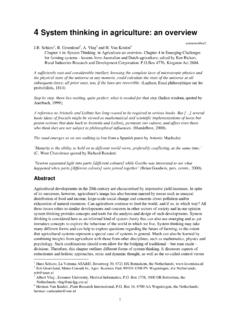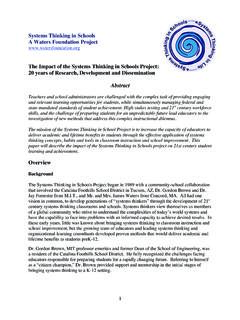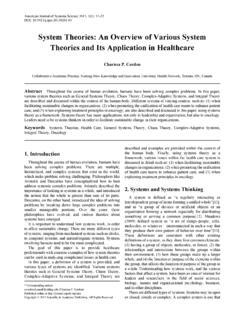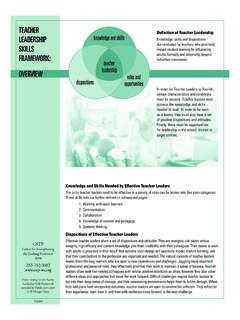Transcription of Systems Thinking Overview - School of Forest …
1 Systems Thinking Overview A system is a set of variables or parts that interact with each other. Examples of natural Systems are forests and the solar system ; designed Systems are airports or schools. Systems behave according to the relationships that the parts have with each other. Complex Systems are challenging to understand, and their future behavior is difficult to predict. Systems Thinking is a form of critical Thinking that helps learners understand complex, dynamic Systems . It includes identifying the boundaries and parts of a system , the relationships between those parts, and how the system behaves over time. Typically we try to simplify complexity into direct or linear relationships.
2 However, Systems Thinking enables learners to practice seeing indirect effects, feedback loops, cycles, delays, and potentially surprising outcomes, such as exponential growth. Why Incorporate Systems Thinking ? To promote problem solving and critical Thinking skills To address new performance-based expectations in the NGSS and Common Core To develop future leaders capable of addressing complex global issues Tools for Systems Thinking Causal Loop Diagram Behavior Over Time Graph Stock-Flow Diagram Computer Simulation Model This diagram shows feedback loops in a predator/prey relationship. The S s indicate a relationship that has the same direction (if one increases so does the other).
3 The O s represent an opposite relationship. More complex diagrams help to show not only the direct connections, but indirect connections as well. The behavior over time graph demonstrates trends and patterns in a system . This helps to show short term and long term impacts and possible effects of delay. A stock-flow diagram illustrates inputs and outputs of a system , usually indicating rate or volume. An example could be the amount of carbon that is added to and removed from the atmosphere. Computer models help learners visualize long term impacts from many variables. The example below shows potential sea level rise in the southeastern United States. Models simulate known direct and indirect impacts to a system over time to reveal unexpected outcomes.
4 Of rabbits of rabbits Assessing Introductory Skills in Systems Thinking * from Plate, R., & Monroe, M. 2014. A Structure for Assessing Systems Thinking , The Creative Learning Exchange, 23(1): 1-6 [Online]: #page=1 Skill 1: Recognize Interconnections Below Basic Systems Literacy Recognizes only linear connections; does not look for connections not included in prior beliefs Basic Systems Literacy Includes some non-linear connections in understanding of causal structure of a system ; can understand an explanation of a system s behavior in terms of non-linear causal structures Intermediate Systems Literacy Includes many non-linear connections in one s understanding of the causal structure of a system ; actively looks for connections beyond prior beliefs.
5 Can explain a Systems behavior in terms of non-linear causal structures Advanced Systems Literacy Can develop a quantitative model of complex Systems that provides insights into how impacts will ripple across a system Skill 2: Identify Feedback Below Basic Systems Literacy Little or no understanding of the role that feedback plays in a system Basic Systems Literacy Understands the basic role of feedback in a system ; can understand an explanation of a system s behavior in terms of feedback Intermediate Systems Literacy Can identify feedback loops in complex Systems and explain a system s behavior in the context of those feedback loops Advanced Systems Literacy Can incorporate multiple feedback loops in quantitative models to predict the varying influence of such feedback at different points in time Skill 3.
6 Understand Systems at Different Scales Below Basic Systems Literacy Tends to interpret system behavior on a single scale (typically individual and short-term) Basic Systems Literacy Understands that the behavior observed at any specific scale of a system is affected by broader and narrower levels of scale Intermediate Systems Literacy Can explain the behavior of a system in terms of interconnections between variables at multiple scales Advanced Systems Literacy Can incorporate behavioral interactions at multiple scales into a quantitative model Skill 4: Differentiate Types of Stocks and Flows Below Basic Systems Literacy Little or no understanding of the relationship between stocks and flows Basic Systems Literacy Has a conceptual understanding of the distinction between stocks and flows.
7 Can follow an explanation of a Systems behavior in the context of the interactions between multiple stocks Intermediate Systems Literacy Has a conceptual and practical understanding of stocks and flows and can interpret the behavior of a system based on this understanding Advanced Systems Literacy Can develop a model with multiple stocks and flows and use that model to make valid inferences about the behavior of the system Skill 5: Understand Dynamic Behavior Below Basic Systems Literacy Has a static mental model of a system ; does not incorporate the idea of change over time Basic Systems Literacy Has a basic conceptual understanding that Systems change over time; can understand explanations of a system s behavior in terms of non-linear causal structures, feedback, and stocks and flows Intermediate Systems Literacy Has a thorough understanding of how Systems change over time, which includes fast- and slowly-changing variables and delayed feedback.
8 Can develop reasonable hypotheses about a system s behavior in the context of non-linear causal structures, feedback, and stocks and flows Advanced Systems Literacy Can develop quantitative models to test hypotheses and explore scenarios regarding how a system may change over time. *Skills 6 and 7 not shown












